上海牛津版一年级上册英语1AM4U2Inthezoo
- 格式:pdf
- 大小:886.56 KB
- 文档页数:6
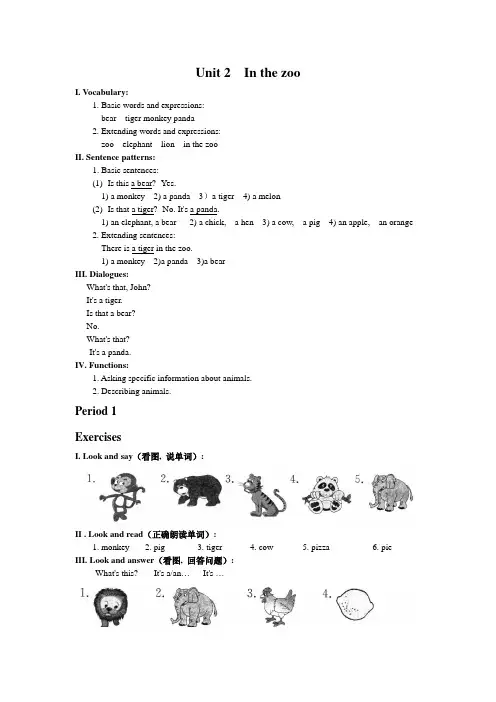
Unit 2 In the zooI. Vocabulary:1. Basic words and expressions:bear tiger monkey panda2. Extending words and expressions:zoo elephant lion in the zooII. Sentence patterns:1. Basic sentences:(1) -Is this a bear? -Yes.1) a monkey 2) a panda 3)a tiger 4) a melon(2) -Is that a tiger? -No. It's a panda.1) an elephant, a bear 2) a chick, a hen 3) a cow, a pig 4) an apple, an orange2. Extending sentences:There is a tiger in the zoo.1) a monkey 2)a panda 3)a bearIII. Dialogues:-What's that, John?-It's a tiger.-Is that a bear?-No.-What's that?- It's a panda.IV. Functions:1. Asking specific information about animals.2. Describing animals.Period 1ExercisesI. Look and say(看图, 说单词):II . Look and read(正确朗读单词):1. monkey2. pig3. tiger4. cow5. pizza6. pieIII. Look and answer(看图, 回答问题):-What's this? -It's a/an…It's …IV. Say and play(带上一个动物面具, 并介绍): Hello! I'm a…V. Listen and circle(听录音, 圈出正确的图片):VI. Listen and number(听录音, 将所给图片正确编号):VII. Listen and match(听录音, 将人物与图片正确连线): l. Alice2. Peter3. Ben4. Miss Fang5. JohnVIII. Listen and choose(听录音, 选择听到的句子):( ) 1. A. What can you do? B. What can you see?( ) 2. A. This is a tiger. B. That is a lion.( ) 3. A. The duck is small. B. The bear is big.( ) 4. A. I can see a fat pig. B. I can see a big horse.( ) 5. A. She is in the zoo. B. He is in the zoo.IX. Read and choose(看单词, 选择正确的图片):( ) 1. bear( ) 2. monkey( ) 3. panda( ) 4. lionX. Read and judge(依据所给的单词, 推断图片是否正确, 用“√”或“×”表示): 1. horse ( ) 2. elephant ( )3. tiger ( )4. cow ( )XI. Read and circle(看一看, 圈出与例词相同的词):1. bear n b a e b e a r u y2. tiger f d s t i g e r o pPeriod 2ExercisesI. Look and say(看图, 说单词):II. Look and say (正确朗读单词)1. fat2. zoo3. elephant4. mask5. cut III. Ask and answer(看图回答问题):1. Is this a tiger?2. Is this a panda?3. Is this a monkey?4. Is this a bear?IV. Mime an animal and try to introduce(仿照动物并做介绍):Hello! I'm…V. Listen and circle(听录音, 圈出正确的图片):VI. Listen and number(听录音, 给单词正确编号):panda bear elephant monkey tiger( ) ( ) ( ) ( ) ( )VII. Listen and judge(听录音, 推断听到的内容是否与图片全都, 用“√”或“×”表示):VIII. Listen and choose(听录音, 选择听到的句子):( ) 1. A. How many tigers? B. This is a tiger.( ) 2. A. This is your mouth. B. This is a monkey.( ) 3. A. I can see a panda. B. I'm a panda.( ) 4. A. Touch your ears. B. Touch your face.( ) 5. A. Is this a pear? B. Is this a peach?IX. Read and judge(依据所给的单词, 推断图片是否正确, 用“√”或“×”表示):1. panda2. bear3. monkey4. pieX. Read and choose(看图, 选择正确的单词):( ) 1. A. hamburger B. horse( ) 2. A. farm B. elephant( ) 3. A. tiger B. monkey( ) 4. A. lemon B. lionXI. Read and circle(看一看, 圈出与例词相同的词):l. monkey o m o n k e y s p u2. panda h o m p a n d a n gPeriod 3ExercisesI. Look and say(看图, 说单词):II . Look and read(正确朗读词组):l. in the zoo 2. on the farm 3. make a mask 4. in the restaurant III. Look and say(看图, 用所给句型说话):There's a…in the zoo.IV. Sing a song(唱一首英语歌曲“In the zoo")V. Listen and circle(听录音, 圈出正确的图片):VI. Listen and circle(听录音, 圈出听到的单词):1. A. farm B. five2. A. small B. draw3. A. cow B. two4. A. mother B. monkey5. A. pen B. hen6. A. soup B. singVII. Listen and choose(听录音, 选择听到的句子):( ) 1. A. This is a tiger. B. There's a tiger in the zoo. ( ) 2. A. Is this a panda? B. This is a panda.( ) 3. A. What's that? B. What's this?( ) 4. A. There's a duck on the farm. B. There's a bear in the zoo. ( ) 5. A. Nice to see you. B. How are you?M. Listen and match (听录音, 将人物与图片正确连线):IX. Look and choose(看图, 选择正确的图片):( ) 1. He is a ___________boy. A. fat B. thin( ) 2. May I have a __________? A. book B. banana ( ) 3. I can _________. A. sing B. read ( ) 4. - Who's she? -She's ________. A. Ann B. AliceX. Read and judge(依据所给的单词,推断图片是否正确, 用“√”或“×”表示):1. pie2. monkey3. six4. bookXI. Read and circle(看一看, 圈出与例词相同的词):1. elephant e l e p h a n t x w2. lion p c w t l i o n p kRevision for Module 4 Unit 2 SpeakingI. Look and say(看图, 说单词): 10%II. Look and read(正确朗读单词):5%l. farm 2. zoo 3. bread 4. rabbit 5. tall III. Look and answer(看图, 回答问题): 10%1. Is this a bear?2. Is this a monkey?3. How many pandas?4. May I have a cake?5. What’s this?IV. Quick responses(快速反应): 10%1. How are you?2. Give me a peach, please.3. Can I help you?4. May I have a banana?5. Touch your nose, please.V. Look and read正确朗读句子):10%1. There's a lion in the zoo.2. There's a cow on the farm.3. There's a boy in the restaurant.4. How many tigers?5. Give me a hamburger, please.VI. Sing a song(唱一首英语儿歌): 5%ListeningI. Listen and circle(听录音, 圈出正确的图片): 10%II. Listen and circle(听录音, 圈出听到的单词): 10%1. A. father B. fruit2. A. chips B. peach3. A. melon B. mother4. A. duck B. chick5. A. apple B. peach6. A. tiger B. ten7. A. farm B. five 8. A. pizza B. pencil9. A. hen B. hi 10. A. bear B. pearIII. Listen and judge(听录音, 推断听到的内容是否与图片全都, 用“√”或“×”表示): 5%III. Listen and match(听录音, 将动物与叫声正确连线): 5%A. Oink, oink.B. Moo, moo.C. Peep, peep.D. Quack, quack.E. Nay, nay.V. Listen and choose(听录音,选择正确的应答句):10%( ) 1. A. There is a duck. B. It's a duck.( ) 2. A. Seven monkeys. B. This is a monkey.( ) 3. A. I love tigers. B. Yes, it is.( ) 4. A. No, it isn't. B. It's a lion.( ) 5. A. I can see a panda. B. I can draw a panda.WritingI. Read and match(将动物与地点正确连线): 6%cow horse tiger chick elephant bearII. Read and choose(选择不同类的词): 4%( ) l. A. panda B. pencil C. book D. knife( ) 2. A. ten B. nine C. cake D. eight( ) 3. A. cow B. pig C. horse D. banana( ) 4. A. father B. friend C. mother D. uncleUnit 2 In the zooPeriod 1ExercisesV. Listen and circle(听录音, 圈出正确的图片):l. bear (A) 2. elephant (A) 3. cow (A) 4. panda (B) 5. horse (B) 6. monkey (B) VI. Listen and number(听录音, 将所给图片正确编号):lion, tiger, elephant, bear, monkey (3, 1, 5,2,4)VII. Listen and match(听录音, 将人物与图片正确连线):1. Alice loves monkeys. (C)2. Peter loves pandas. (D)3. Ben loves lions. (E)4. Miss Fang loves tigers. (A)5. John loves bears. (B)VIII. Listen and choose(听录音, 选择听到的句子):1. What can you see? (B)2. This is a tiger. (A)3. The duck is small. (A)4. I can see a big horse. (B)5. He is in the zoo. (B)IX. 1.B 2.B 3.A 4.BX. 1.×2.√3.√4.×XI. 略Period 2ExercisesV. Listen and circle(听录音, 圈出正确的图片):1. elephant (A)2. monkey (B)3. lion (B)4. duck (B)5. pizza (A)6. orange (A) VI. Listen and number(听录音, 给单词正确编号):monkey, tiger, bear, panda, elephant (4, 3, 5, 1,2)VII. Listen and judge(听录音, 推断听到的内容是否与图片全都, 用“√”或“×”表示):1. I love lions.(×)2. I can see an elephant.(√)3. Oink, oink, I can hear a pig.(×)4. This is five. (×)5. Give me a pen, please. (×)VIII. Listen and choose(听录音, 选择听到的句子):l. This is a tiger. (B) 2. This is your mouth. (A) 3. I'm a panda. (B) 4. Touch your ears. (A) 5. Is this a peach? (B)IX. 1.× 2.× 3. √ 4.×X. l. A 2. B 3. A 4. BXI. 略Period 3ExercisesV . Listen and circle(听录音, 圈出正确的图片):1. bread (B)2. elephant (A)3. panda (A)4. chips (A)5. pie (B)6. tall (B)VI. Listen and circle(听录音, 圈出听到的单词):1. five (B)2. small (A)3. cow (A)4. monkey (B)5. hen (B)6. soup (A)VII. Listen and choose(听录音, 选择听到的句子):1. There's a tiger in the zoo. (B)2. Is this a panda? (A)3. What's this? (B)4. There's a duck on the farm. (A)5. How are you? (B)VIII. Listen and match(听录音, 将人物与图片正确连线):1. Ann loves pandas. (B)2. Kitty loves monkeys. (C)3. Danny loves tigers. (D)4. Ben loves elephants. (A)IX. 1.B 2.B 3.B 4.AX. 1.× 2.× 3.× 4. √XI. 略Revision for Module 4 Unit 2ListeningI. Listen and circle(听录音, 圈出正确的图片):1. panda (B)2. ten (A)3. lemon, (A)4. duck (A) 5, three (B)II . Listen and circle(听录音, 圈出听到的单词):1. fruit (B)2. chips (A)3. melon (A)4. duck (A)5. peach (B)6. ten (B)7. farm (A) 8. pencil (B) 9. hen (A) 10. pear (B)III. Listen and judge(听录音, 推断听到的内容是否与图片全都, 用“√”或“×”表示): l. This is four.(√)2. He loves ,tigers.(×)3. I can see a cow.(√)4. That is a melon. (×)5. -What's this? -It's a pig. (×)IV. Listen and match(听录音, 将动物与叫声正确连线):1. This is a chick. Peep, peep. (C)2. This is a pig. Oink, oink. (A)3. This is a cow.Moo, moo. (B) 4. This is a horse. Nay, nay. (E) 5. This is a duck. Quack, quack. (D) V. Listen and choose(听录音, 选择正确的应答句): 10%1. What's this? (B)2. How many monkeys? (A)3. Is this a tiger? (B)4. Is that a lion? (A)5. What can you see? (A)WritingI. 略II. 1. A 2. C 3. D 4. B。
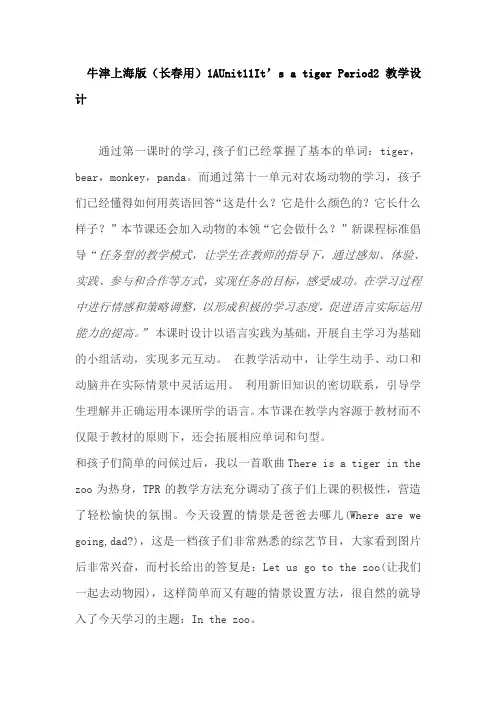
牛津上海版(长春用)1AUnit11It’s a tiger Period2 教学设计通过第一课时的学习,孩子们已经掌握了基本的单词:tiger,bear,monkey,panda。
而通过第十一单元对农场动物的学习,孩子们已经懂得如何用英语回答“这是什么?它是什么颜色的?它长什么样子?”本节课还会加入动物的本领“它会做什么?”新课程标准倡导“任务型的教学模式,让学生在教师的指导下,通过感知、体验、实践、参与和合作等方式,实现任务的目标,感受成功。
在学习过程中进行情感和策略调整,以形成积极的学习态度,促进语言实际运用能力的提高。
”本课时设计以语言实践为基础,开展自主学习为基础的小组活动,实现多元互动。
在教学活动中,让学生动手、动口和动脑并在实际情景中灵活运用。
利用新旧知识的密切联系,引导学生理解并正确运用本课所学的语言。
本节课在教学内容源于教材而不仅限于教材的原则下,还会拓展相应单词和句型。
和孩子们简单的问候过后,我以一首歌曲There is a tiger in the zoo为热身,TPR的教学方法充分调动了孩子们上课的积极性,营造了轻松愉快的氛围。
今天设置的情景是爸爸去哪儿(Where are we going,dad?),这是一档孩子们非常熟悉的综艺节目,大家看到图片后非常兴奋,而村长给出的答复是:Let us go to the zoo(让我们一起去动物园),这样简单而又有趣的情景设置方法,很自然的就导入了今天学习的主题:In the zoo。
在介绍动物园里的小动物时,我运用了三个不同层次的呈现方法:一.在介绍老虎tiger和猴子monkey这两个单词时,直接出示图片,教师引导学生回答相应问题。
T:What's this?Ss:It's a tiger.T:What colour is it?Ss:It's a yellow and black.T:How is it?Ss:It's big.T:What can it do?Ss:It can run.在介绍的过程中,板书:It's a... It's... It's...It's... It can...在动物图片下,分别加上合适的单词。
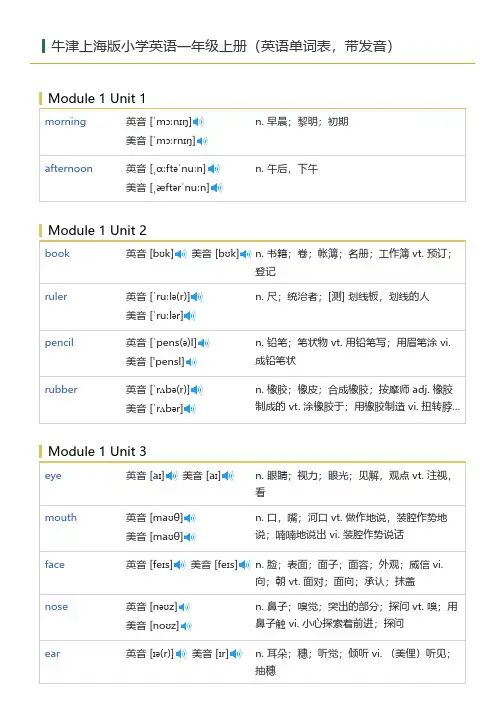
牛津上海版小学英语一年级上册(英语单词表,带发音)Module 1 Unit 1Module 1 Unit 2Module 1 Unit 3morning英音 [ˈm ɔːn ɪŋ]美音 [ˈm ɔːrn ɪŋ]n. 早晨;黎明;初期afternoon英音 [ˌɑːftəˈnu ːn]美音 [ˌæft ər ˈnu ːn]n. 午后,下午book英音 [b ʊk]美音 [b ʊk]n. 书籍;卷;帐簿;名册;工作簿 vt. 预订;登记ruler英音 [ˈru ːl ə(r)]美音 [ˈru ːl ər]n. 尺;统治者;[测] 划线板,划线的人pencil英音 [ˈpens(ə)l]美音 [ˈpensl]n. 铅笔;笔状物 vt. 用铅笔写;用眉笔涂 vi.成铅笔状rubber英音 [ˈrʌb ə(r)]美音 [ˈr ʌb ər]n. 橡胶;橡皮;合成橡胶;按摩师 adj. 橡胶制成的 vt. 涂橡胶于;用橡胶制造 vi. 扭转脖…eye英音 [a ɪ]美音 [a ɪ]n. 眼睛;视力;眼光;见解,观点 vt. 注视,看mouth英音 [ma ʊθ]美音 [ma ʊθ]n. 口,嘴;河口 vt. 做作地说,装腔作势地说;喃喃地说出 vi. 装腔作势说话face英音 [fe ɪs]美音 [fe ɪs]n. 脸;表面;面子;面容;外观;威信 vi.向;朝 vt. 面对;面向;承认;抹盖nose英音 [n əʊz]美音 [no ʊz]n. 鼻子;嗅觉;突出的部分;探问 vt. 嗅;用鼻子触 vi. 小心探索着前进;探问ear英音 [ɪə(r)]美音 [ɪr]n. 耳朵;穗;听觉;倾听 vi. (美俚)听见;抽穗Module 2 Unit 1Module 2 Unit 2Module 2 Unit 3dance英音 [dɑːns]美音 [dæns]n. 舞蹈;舞会;舞曲 adj. 舞蹈的;用于跳舞的 vt. 跳舞;使跳跃 vi. 跳舞;跳跃;飘扬read英音 [ri ːd]美音 [ri ːd]n. 阅读;读物 adj. 有学问的 vi. 读;读起来vt. 阅读;读懂,理解sing英音 [s ɪŋ]美音 [s ɪŋ]n. 演唱;鸣声;呼啸声 vt. 唱;用诗赞颂;唱着使 vi. 唱歌;歌颂;鸣叫;呼号draw英音 [dr ɔː]美音 [dr ɔː]n. 平局;抽签 vi. 拉;拖 vt. 画;拉;吸引grandfather英音 [ˈɡrænfɑːðə(r)]美音 [ˈɡrænfɑːðər]n. 祖父;始祖 vt. 不受新规定限制grandmother英音 [ˈɡrænm ʌðə(r)]美音 [ˈɡrænm ʌðər]n. 祖母;女祖先 vt. 当…的祖母 vi. 当祖母father英音 [ˈfɑːðə(r)]美音 [ˈfɑːðər]n. 父亲,爸爸;神父;祖先;前辈 vt. 发明,创立;当…的父亲mother英音 [ˈm ʌðə(r)]美音 [ˈm ʌðər]n. 母亲;大娘;女修道院院长 vt. 生下;养育;像母亲般关怀或照管 adj. 母亲的;出生…me英音 [mi; mi ː]美音 [mi; mi ː]pron. 我(宾格) n. 自我;极端自私的人;自我的一部分fat英音 [fæt]美音 [fæt]n. 脂肪,肥肉 adj. 肥的,胖的;油腻的;丰满的 vt. 养肥;在…中加入脂肪 vi. 长肥thin英音 [θɪn]美音 [θɪn]n. 细小部分 adj. 薄的;瘦的;稀薄的;微弱的 vt. 使瘦;使淡;使稀疏 vi. 变薄;变瘦;…tall英音 [t ɔːl]美音 [t ɔːl]adj. 高的;长的;过分的;夸大的 adv. 夸大地short英音 [ʃɔːt]美音 [ʃɔːrt]n. 短;缺乏;短路;短裤 adj. 短的;不足的;矮的,低的 adv. 不足;突然;唐突地Module 3 Unit 1Module 3 Unit 2Module 3 Unit 3的;矮的,低的不足;突然;唐突地one英音 [w ʌn]美音 [w ʌn]pron. 一个人;任何人 adj. 一的;唯一的 n.一 num. 一;一个two 英音 [tu ː]美音 [tu ː]num. 二 n. 两个 adj. 两个的three 英音 [θri ː]美音 [θri ː]num. 三 n. 三,三个 adj. 三的,三个的four 英音 [f ɔː(r)]美音 [f ɔːr]num. 四;四个 adj. 四的;四个的five英音 [fa ɪv]美音 [fa ɪv]num. 五,五个 n. 五,五个;五美元钞票 adj.五的;五个的six英音 [s ɪks]美音 [s ɪks]num. 六,六个 n. 六,六个apple英音 [ˈæp(ə)l]美音 [ˈæpl]n. 苹果,苹果树,苹果似的东西;[美俚]炸弹,手榴弹,(棒球的)球;[美俚]人,家…pear英音 [pe ə(r)]美音 [per]n. [园艺] 梨树;梨子peach英音 [pi ːt ʃ]美音 [pi ːt ʃ]n. 桃子;桃树;桃红色;受人喜欢的人(或物) adj. 桃色的;用桃子制成的 vt. 告发 vi.…orange英音 [ˈɒr ɪnd ʒ]美音 [ˈɔr ɪnd ʒ]adj. 橙色的;橘色的 n. 橙;橙色;桔子hamburger英音 [ˈhæmb ɜːɡə(r)]美音 [ˈhæmb ɜːrɡər]n. 汉堡包,火腿汉堡;牛肉饼,肉饼;碎牛肉pizza英音 [ˈpi ːts ə]美音 [ˈpi ːts ə]n. 比萨饼(一种涂有乳酪核番茄酱的意大利式有馅烘饼)cake英音 [ke ɪk]美音 [ke ɪk]n. 蛋糕;块状物;利益总额 vt. 使结块 vi. 结成块状Module 4 Unit 1Module 4 Unit 2Module 4 Unit 3pie 英音 [pa ɪ]美音 [pa ɪ]n. 馅饼;饼图;爱说话的人 vt. 使杂乱chick 英音 [t ʃɪk]美音 [t ʃɪk]n. 小鸡;小鸟;少妇 adj. 胆小的;懦弱的duck英音 [d ʌk]美音 [d ʌk]n. 鸭子;鸭肉;(英)宝贝儿;零分 vt. 躲避;猛按…入水 vi. 闪避;没入水中cow 英音 [ka ʊ]美音 [ka ʊ]n. 奶牛,母牛;母兽 vt. 威胁,恐吓pig英音 [p ɪɡ]美音 [p ɪɡ]n. 猪;猪肉 vi. 生小猪;像猪一样过活 n. 警察(俚语,带有攻击性)bear英音 [be ə(r)]美音 [ber]n. 熊 vt. 结果实,开花(正式) vt. 忍受;承受;具有;支撑tiger英音 [ˈta ɪɡə(r)]美音 [ˈta ɪɡər]n. 老虎;凶暴的人monkey英音 [ˈm ʌŋki]美音 [ˈm ʌŋki]n. 猴子;顽童 vi. 胡闹;捣蛋 vt. 嘲弄panda英音 [ˈpænd ə]美音 [ˈpænd ə]n. 熊猫;猫熊red英音 [red]美音 [red]n. 红色,红颜料;赤字 adj. 红色的;红肿的,充血的blue英音 [blu ː]美音 [blu ː]adj. 蓝色的;沮丧的,忧郁的;下流的 n. 蓝色;[复数](美国海、陆、空三军穿的)蓝…yellow英音 [ˈjel əʊ]美音 [ˈjelo ʊ]n. 黄色;黄种人;黄色颜料 adj. 黄色的;黄皮肤的 vt. 使变黄或发黄 vi. 变黄或发黄green英音 [ɡri ːn]美音 [ɡri ːn]n. 绿色;青春 adj. 绿色的;青春的 vt. 使…变绿色 vi. 变绿色。
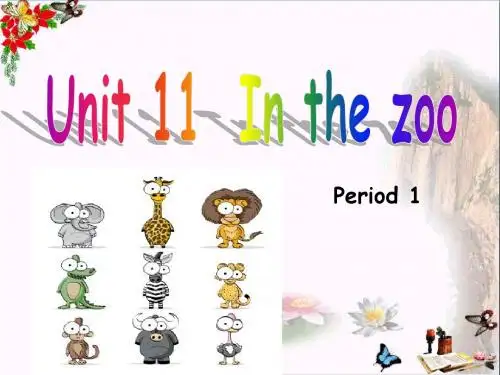

Unit 2 In the zooI. Vocabulary:1. Basic words and expressions:bear tiger monkey panda2. Extending words and expressions:zoo elephant lion in the zooII. Sentence patterns:1. Basic sentences:(1) -Is this a bear? -Yes.1) a monkey 2) a panda 3)a tiger 4) a melon(2) -Is that a tiger? -No. It's a panda.1) an elephant, a bear 2) a chick, a hen 3) a cow, a pig 4) an apple, an orange2. Extending sentences:There is a tiger in the zoo.1) a monkey 2)a panda 3)a bearIII. Dialogues:-What's that, John?-It's a tiger.-Is that a bear?-No.-What's that?- It's a panda.IV. Functions:1. Asking specific information about animals.2. Describing animals.Period 1ExercisesI. Look and say(看图, 说单词):II . Look and read(正确朗读单词):1. monkey2. pig3. tiger4. cow5. pizza6. pieIII. Look and answer(看图, 回答问题):-What's this? -It's a/an…It's …IV. Say and play(带上一个动物面具, 并介绍): Hello! I'm a…V. Listen and circle(听录音, 圈出正确的图片):VI. Listen and number(听录音, 将所给图片正确编号):VII. Listen and match(听录音, 将人物与图片正确连线):l. Alice2. Peter3. Ben4. Miss Fang5. JohnVIII. Listen and choose(听录音, 选择听到的句子):( ) 1. A. What can you do? B. What can you see?( ) 2. A. This is a tiger. B. That is a lion.( ) 3. A. The duck is small. B. The bear is big.( ) 4. A. I can see a fat pig. B. I can see a big horse.( ) 5. A. She is in the zoo. B. He is in the zoo.IX. Read and choose(看单词, 选择正确的图片):( ) 1. bear( ) 2. monkey( ) 3. panda( ) 4. lionX. Read and judge(根据所给的单词, 判断图片是否正确, 用“√”或“×”表示):1. horse ( )2. elephant ( )3. tiger ( )4. cow ( )XI. Read and circle(看一看, 圈出与例词相同的词):1. bear n b a e b e a r u y2. tiger f d s t i g e r o pPeriod 2ExercisesI. Look and say(看图, 说单词):II. Look and say (正确朗读单词)1. fat2. zoo3. elephant4. mask5. cut III. Ask and answer(看图回答问题):1. Is this a tiger?2. Is this a panda?3. Is this a monkey?4. Is this a bear?IV. Mime an animal and try to introduce(模仿动物并做介绍):Hello! I'm…V. Listen and circle(听录音, 圈出正确的图片):VI. Listen and number(听录音, 给单词正确编号):panda bear elephant monkey tiger( ) ( ) ( ) ( ) ( )VII. Listen and judge(听录音, 判断听到的内容是否与图片一致, 用“√”或“×”表示):VIII. Listen and choose(听录音, 选择听到的句子):( ) 1. A. How many tigers? B. This is a tiger.( ) 2. A. This is your mouth. B. This is a monkey.( ) 3. A. I can see a panda. B. I'm a panda.( ) 4. A. Touch your ears. B. Touch your face.( ) 5. A. Is this a pear? B. Is this a peach?IX. Read and judge(根据所给的单词, 判断图片是否正确, 用“√”或“×”表示):1. panda2. bear3. monkey4. pieX. Read and choose(看图, 选择正确的单词):( ) 1. A. hamburger B. horse( ) 2. A. farm B. elephant( ) 3. A. tiger B. monkey( ) 4. A. lemon B. lionXI. Read and circle(看一看, 圈出与例词相同的词):l. monkey o m o n k e y s p u2. panda h o m p a n d a n gPeriod 3ExercisesI. Look and say(看图, 说单词):II . Look and read(正确朗读词组):l. in the zoo 2. on the farm 3. make a mask 4. in the restaurant III. Look and say(看图, 用所给句型说话):There's a…in the zoo.IV. Sing a song(唱一首英语歌曲“In the zoo")V. Listen and circle(听录音, 圈出正确的图片):VI. Listen and circle(听录音, 圈出听到的单词):1. A. farm B. five2. A. small B. draw3. A. cow B. two4. A. mother B. monkey5. A. pen B. hen6. A. soup B. singVII. Listen and choose(听录音, 选择听到的句子):( ) 1. A. This is a tiger. B. There's a tiger in the zoo. ( ) 2. A. Is this a panda? B. This is a panda.( ) 3. A. What's that? B. What's this?( ) 4. A. There's a duck on the farm. B. There's a bear in the zoo. ( ) 5. A. Nice to see you. B. How are you?M. Listen and match (听录音, 将人物与图片正确连线):IX. Look and choose(看图, 选择正确的图片):( ) 1. He is a ___________boy. A. fat B. thin( ) 2. May I have a __________? A. book B. banana( ) 3. I can _________. A. sing B. readX. Read and judge(根据所给的单词,判断图片是否正确, 用“√”或“×”表示):1. pie2. monkey3. six4. bookXI. Read and circle(看一看, 圈出与例词相同的词):1. elephant e l e p h a n t x w2. lion p c w t l i o n p kRevision for Module 4 Unit 2 SpeakingI. Look and say(看图, 说单词): 10%II. Look and read(正确朗读单词):5%l. farm 2. zoo 3. bread 4. rabbit 5. tall III. Look and answer(看图, 回答问题): 10%1. Is this a bear?2. Is this a monkey?3. How many pandas?4. May I have a cake?5. What’s this?IV. Quick responses(快速反应): 10%1. How are you?2. Give me a peach, please.3. Can I help you?4. May I have a banana?5. Touch your nose, please.V. Look and read正确朗读句子):10%1. There's a lion in the zoo.2. There's a cow on the farm.3. There's a boy in the restaurant.4. How many tigers?5. Give me a hamburger, please.VI. Sing a song(唱一首英语儿歌): 5%ListeningI. Listen and circle(听录音, 圈出正确的图片): 10%II. Listen and circle(听录音, 圈出听到的单词): 10%1. A. father B. fruit2. A. chips B. peach3. A. melon B. mother4. A. duck B. chick5. A. apple B. peach6. A. tiger B. ten7. A. farm B. five 8. A. pizza B. pencil9. A. hen B. hi 10. A. bear B. pearIII. Listen and judge(听录音, 判断听到的内容是否与图片一致, 用“√”或“×”表示): 5%III. Listen and match(听录音, 将动物与叫声正确连线): 5%A. Oink, oink.B. Moo, moo.C. Peep, peep.D. Quack, quack.E. Nay, nay.V. Listen and choose(听录音,选择正确的应答句):10%( ) 1. A. There is a duck. B. It's a duck.( ) 2. A. Seven monkeys. B. This is a monkey.( ) 3. A. I love tigers. B. Yes, it is.( ) 4. A. No, it isn't. B. It's a lion.( ) 5. A. I can see a panda. B. I can draw a panda.WritingI. Read and match(将动物与地点正确连线): 6%cow horse tiger chick elephant bearII. Read and choose(选择不同类的词): 4%( ) l. A. panda B. pencil C. book D. knife( ) 2. A. ten B. nine C. cake D. eight( ) 3. A. cow B. pig C. horse D. banana( ) 4. A. father B. friend C. mother D. uncleUnit 2 In the zooPeriod 1ExercisesV. Listen and circle(听录音, 圈出正确的图片):l. bear (A) 2. elephant (A) 3. cow (A) 4. panda (B) 5. horse (B) 6. monkey (B) VI. Listen and number(听录音, 将所给图片正确编号):lion, tiger, elephant, bear, monkey (3, 1, 5,2,4)VII. Listen and match(听录音, 将人物与图片正确连线):1. Alice loves monkeys. (C)2. Peter loves pandas. (D)3. Ben loves lions. (E)4. Miss Fang loves tigers. (A)5. John loves bears. (B)VIII. Listen and choose(听录音, 选择听到的句子):1. What can you see? (B)2. This is a tiger. (A)3. The duck is small. (A)4. I can see a big horse. (B)5. He is in the zoo. (B)IX. 1.B 2.B 3.A 4.BX. 1.×2.√3.√4.×XI. 略Period 2ExercisesV. Listen and circle(听录音, 圈出正确的图片):1. elephant (A)2. monkey (B)3. lion (B)4. duck (B)5. pizza (A)6. orange (A) VI. Listen and number(听录音, 给单词正确编号):monkey, tiger, bear, panda, elephant (4, 3, 5, 1,2)VII. Listen and judge(听录音, 判断听到的内容是否与图片一致, 用“√”或“×”表示):1. I love lions.(×)2. I can see an elephant.(√)3. Oink, oink, I can hear a pig.(×)4. This is five. (×)5. Give me a pen, please. (×)VIII. Listen and choose(听录音, 选择听到的句子):l. This is a tiger. (B) 2. This is your mouth. (A) 3. I'm a panda. (B) 4. Touch your ears. (A) 5. Is this a peach? (B)IX. 1.× 2.× 3. √ 4.×X. l. A 2. B 3. A 4. BXI. 略Period 3ExercisesV . Listen and circle(听录音, 圈出正确的图片):1. bread (B)2. elephant (A)3. panda (A)4. chips (A)5. pie (B)6. tall (B)VI. Listen and circle(听录音, 圈出听到的单词):1. five (B)2. small (A)3. cow (A)4. monkey (B)5. hen (B)6. soup (A)VII. Listen and choose(听录音, 选择听到的句子):1. There's a tiger in the zoo. (B)2. Is this a panda? (A)3. What's this? (B)4. There's a duck on the farm. (A)5. How are you? (B)VIII. Listen and match(听录音, 将人物与图片正确连线):1. Ann loves pandas. (B)2. Kitty loves monkeys. (C)3. Danny loves tigers. (D)4. Ben loves elephants. (A)IX. 1.B 2.B 3.B 4.AX. 1.× 2.× 3.× 4. √XI. 略Revision for Module 4 Unit 2ListeningI. Listen and circle(听录音, 圈出正确的图片):1. panda (B)2. ten (A)3. lemon, (A)4. duck (A) 5, three (B)II . Listen and circle(听录音, 圈出听到的单词):1. fruit (B)2. chips (A)3. melon (A)4. duck (A)5. peach (B)6. ten (B)7. farm (A) 8. pencil (B) 9. hen (A) 10. pear (B)III. Listen and judge(听录音, 判断听到的内容是否与图片一致, 用“√”或“×”表示): l. This is four.(√)2. He loves ,tigers.(×)3. I can see a cow.(√)4. That is a melon. (×)5. -What's this? -It's a pig. (×)IV. Listen and match(听录音, 将动物与叫声正确连线):1. This is a chick. Peep, peep. (C)2. This is a pig. Oink, oink. (A)3. This is a cow.Moo, moo. (B) 4. This is a horse. Nay, nay. (E) 5. This is a duck. Quack, quack. (D) V. Listen and choose(听录音, 选择正确的应答句): 10%1. What's this? (B)2. How many monkeys? (A)3. Is this a tiger? (B)4. Is that a lion? (A)5. What can you see? (A)WritingI. 略II. 1. A 2. C 3. D 4. B。
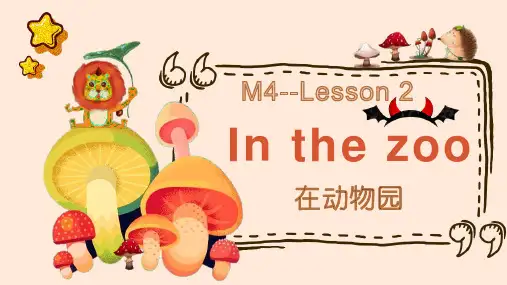
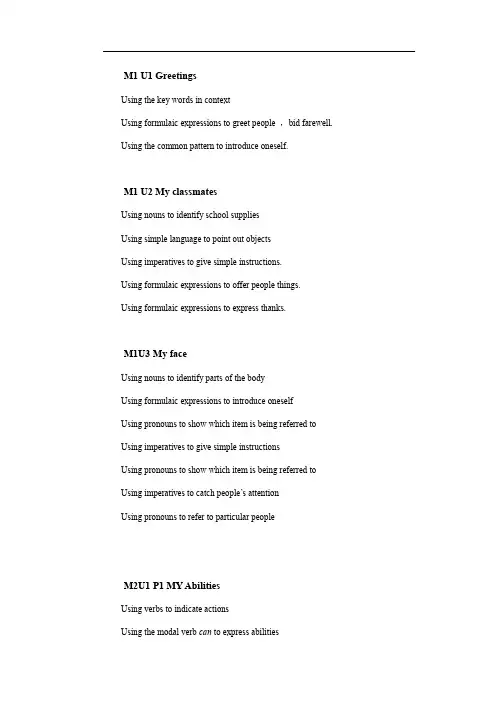
M1 U1 GreetingsUsing the key words in contextUsing formulaic expressions to greet people ,bid farewell. Using the common pattern to introduce oneself.M1 U2 My classmatesUsing nouns to identify school suppliesUsing simple language to point out objectsUsing imperatives to give simple instructions.Using formulaic expressions to offer people things.Using formulaic expressions to express thanks.M1U3 My faceUsing nouns to identify parts of the bodyUsing formulaic expressions to introduce oneselfUsing pronouns to show which item is being referred to Using imperatives to give simple instructionsUsing pronouns to show which item is being referred to Using imperatives to catch people’s attentionUsing pronouns to refer to particular peopleM2U1 P1 MY AbilitiesUsing verbs to indicate actionsUsing the modal verb can to express abilitiesAsking wh-questions to find out a person’s ability. E.g., What can you do?Using verbs to indicate actions. E.g., I can sing.M2U2 My familyUsing pronouns to identify people. E.g., meUsing nouns to identify family members. E.g., mother, father, grandfather, grandmotherUsing nouns to identify family membersUsing possessive adjectives to express possessionAsking wh-questions to find out a person’s identityUsing pronouns to identify peopleUsing formulaic expressions to confirm or denyM2U3 My friendsUsing adjectives to describe people. E.g., thin, fat, tall, shortUsing pronouns to identify peopleUsing adjectives to describe peopleAsking wh-questions to find out a person’s identityUsing the modal verb can to express abilitiesM3U1 In the classroomUsing numerals to count from one to sixUsing numerals to show quantityUsing numerals to count from one to sixUsing numerals to show quantityAsking questions to find out quantity?M3U2 In the fruit shopUsing nouns to identify fruit.e.g., apple, pear, peach, orangeAsking questions to find out quantitye.g., How many..?Using formulaic expressions to request something.Using formulaic expressions to reply requestsUsing formulaic expressions to express thanksM3U3 In the restaurantUsing nouns to identify food.e.g., pizza, hamburger, cake, pieHear specific information in response to simple questions.e.g., Give me a hamburger, please. Here you are.Using formulaic expressions to request somethingUsing an indefinite article to refer to somethingUsing formulaic expressions to greet customersM4U1 On the farmUsing nouns to identify common farm animalsUsing some onomatopoeic words to imitate the sounds of the farm animalsUsing verbs to give instructionsUsing the key pattern to role-play as farm animalAsking wh-questions to find out specific information about something Using a pronoun to refer to somethingM4U2 In the zooUsing nouns to identify animalsUsing adjectives to describe things.Asking yes/no questions to obtain simple responses.e.g., Is this a bear?Using formulaic expressions to confirm or deny.e.g., Yes./No. It’s a panda.M4U3 In the parkUsing adjectives to identify colours.e.g., It’s red.Asking wh-questions to find out the colours of objects.e.g., what colour is it?Using adjectives to identify coloursUsing imperatives to give simple instructionsUsing onomatopoeic words to indicate animal soundsUsing adjectives to describe animalsAsking wh-questions to find out specific information about an animal.。
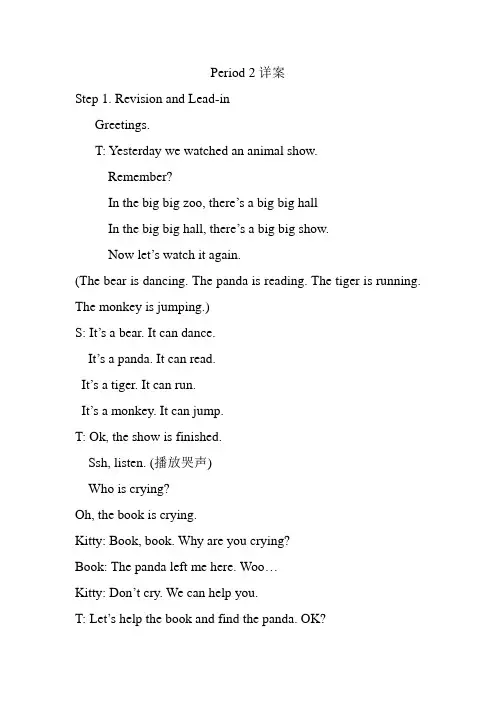
Period 2详案Step 1. Revision and Lead-inGreetings.T: Yesterday we watched an animal show.Remember?In the big big zoo, there’s a big big hallIn the big big hall, there’s a big big show.Now let’s watch it again.(The bear is dancing. The panda is reading. The tiger is running. The monkey is jumping.)S: It’s a bear. It can dance.It’s a panda. It can read.It’s a tiger. It can run.It’s a monkey. It can jump.T: Ok, the show is finished.Ssh, listen. (播放哭声)Who is crying?Oh, the book is crying.Kitty: Book, book. Why are you crying?Book: The panda left me here. W oo…Kitty: Don’t cry. We can help you.T: Let’s help the book and find the panda. OK?Ss: OK?T: Here’s a book. Here’s a book. Here’s a crying book.Let’s go. Let’s go. Let’s go and find the panda.Step 2. Presentation1)T: Panda, panda. Where are you? Your book is crying.Ssh! Listen. (呼噜声)What’s this?Is this a panda? (板书)Follow me. “ Is this a panda?”带读两遍,每组读。